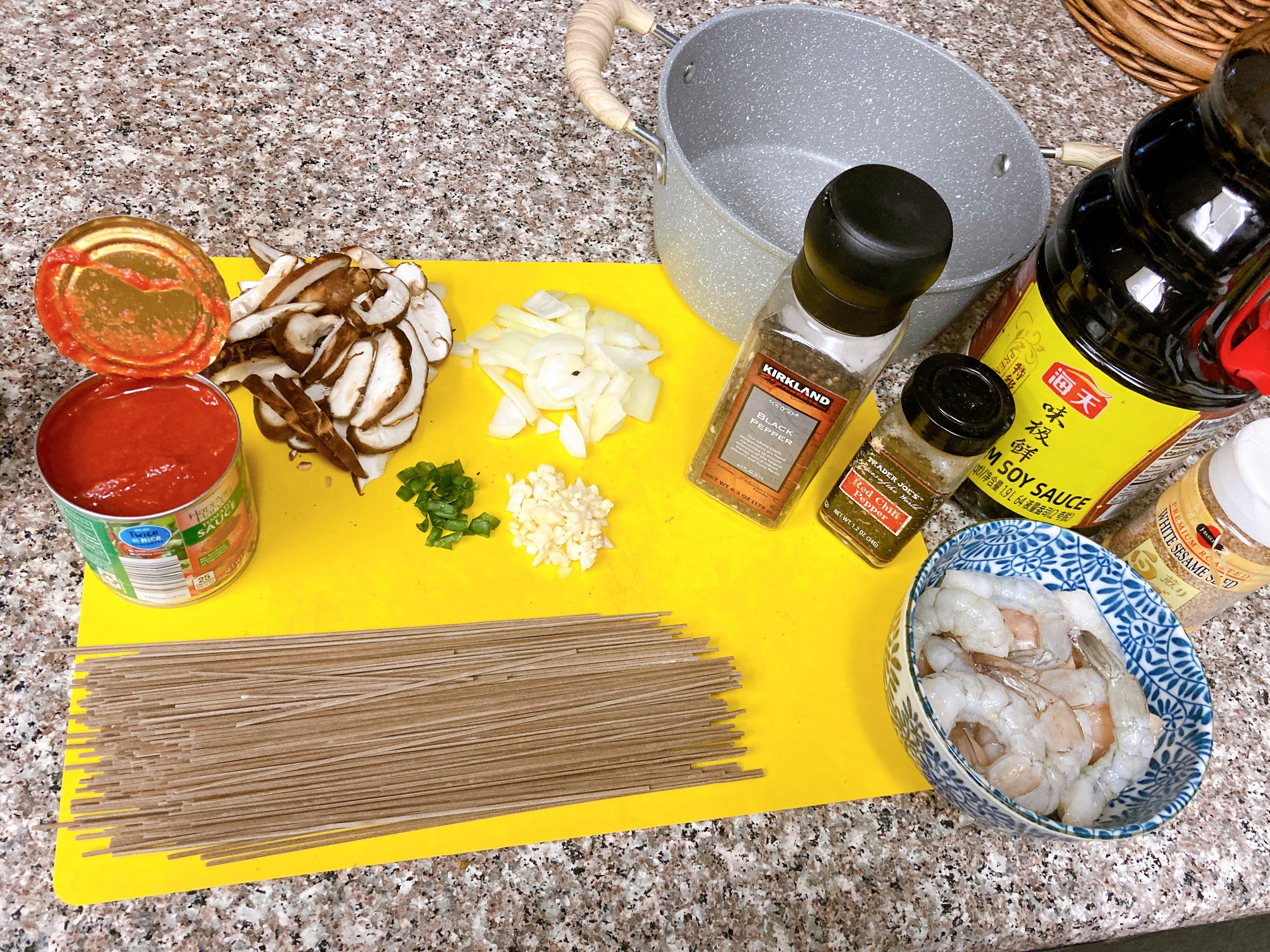Soba Noodle with Marinara Sauce
Author: Isabella Sun
Spaghetti with marinara sauce is a classic Italian dish that is dear to the hearts of many of us. The distinct zesty and herby sauce combined with the chewy noodle makes it a hearty and comforting meal that elicits the memory of being surrounded by loved ones.
On the other side of the globe, soba noodle is another regional dish that symbolizes union. Mostly eaten in Japan and Korea, soba noodle is a highly versatile type of noodle made out of buckwheat flour. On a hot summer day, it can be served as a cold dish on a bamboo tray and eaten with a side of dipping sauce. During a chilly winter night, it can be enjoyed with a hot bowl of dashi-based soup and a side of tempura.
Due to its thin shape and tender texture, soba noodle breaks apart easier than other noodle varieties. This unique quality of soba is how the custom of “Toshikoshi Soba”, or New Year’s Eve Soba, came into existence. On New Year’s Day in Japan, family and friends would gather around and enjoy a bowl of warm soba noodles to symbolize “breaking off the old year.”
Not only is soba noodle a cultural symbol, it is also highly nutritious. Most flour-based food such as rice or ramen noodles are made out of wheat flour, which lacks the amino acid lysine. Soba noodles, on the other hand, are made from the nutrient-dense buckwheat flour, which contains all nine of the essential amino acids our body needs. Historically, the high nutrient value of soba noodle was actually what helped it become popularized in Japan. The buckwheat noodles contain thiamin, an amino acid that was absent in the rice-based everyday meals of the Edo population during the Tokugawa period. As people realized that soba noodles could help prevent thiamin deficiency, it became a staple cuisine in Japan ever since.
Since soba noodles have so many health benefits, it is a shame that we do not eat them more often in our everyday diet. This recipe will show you how to make the classic dish of spaghetti with marinara sauce, but instead of the wheat-based spaghetti noodles, we will be using the similarly shaped soba noodles. The fusion of flavors from West and East is sure to satisfy both adventurous eaters and anyone who simply wants a taste of the unique buckwheat noodles.
Instead of adding in the classic Italian herbs that accentuates the fragrance of the tomato sauce, I decided to opt for a twist by adding two ingredients found in traditional soba noodle dishes: shiitake mushroom and soy sauce. The mushroom and soy sauce add a funky and savory kick that elevate umami flavor without compromising the fragrance of the sauce.
The soba noodles themselves provide another interesting flavor boost to the pasta dish. Their distinct earthy flavor and rough texture contrast with the smooth, savory tomato sauce. All in all, the dish is a fun twist on a traditional comfort meal. This fusion of dishes that represent joy and togetherness from two regions that differ so much culturally and culinarily do not feel jarring. In fact, the key flavors of both dishes blend seamlessly together and amalgamate into a delicious meal that reminds one of home.
Recipe: (serves 2)
Ingredients
4 oz Soba noodle
1 cup tomato sauce
4 shiitake mushroom, sliced
3 cloves of garlic, minced
1/4 onion, chopped
2 tablespoons olive oil
1/2 teaspoon sea salt
1/4 teaspoon black pepper
1/4 teaspoon chili flakes
1/4 teaspoon of roasted sesame
1 spring onion, chopped
Protein of choice
Directions
1. Heat 2 tablespoons of olive oil to a saucepan over medium heat.
2. Add in 1/4 of a chopped onion and sauté until golden and soft.
3. Add in crushed garlic cloves and sauté until fragrant.
4. Pour tomato sauce into the saucepan. Add in chili flake and soy sauce. Stir until well-combined.
5. Cover saucepan with lid. Simmer the sauce on low heat for at least 15 minutes until it thickens in texture. Stir occasionally to prevent burning.
6. Turn off the heat. Stir in black pepper and additional salt to taste.
7. Boil a large pot of water. Add in soba noodles and cook for 6-7 minutes until they have just turned tender.
8. In another pan, sauté the mushroom until they shrink in size and are slightly browned.
9. Stir in the finished sauce and add the cooked protein of choice.
10. Add the cooked noodle to the sauce, mushroom, and protein. Coat the noodle in sauce and stir over medium heat for around 5 minutes. You may add the water that is used to boil the noodle to thin out the sauce if necessary.
11. Transfer finished noodles to a bowl. Garnish chopped spring onion and sesame.












